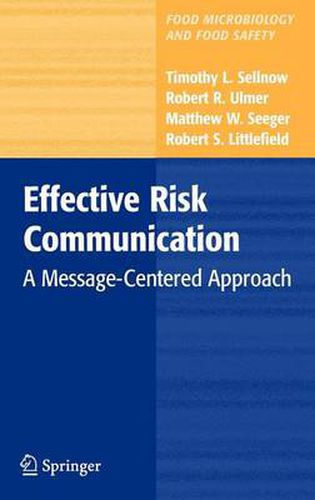Readings Newsletter
Become a Readings Member to make your shopping experience even easier.
Sign in or sign up for free!
You’re not far away from qualifying for FREE standard shipping within Australia
You’ve qualified for FREE standard shipping within Australia
The cart is loading…






This title is printed to order. This book may have been self-published. If so, we cannot guarantee the quality of the content. In the main most books will have gone through the editing process however some may not. We therefore suggest that you be aware of this before ordering this book. If in doubt check either the author or publisher’s details as we are unable to accept any returns unless they are faulty. Please contact us if you have any questions.
Coordination of risk assessments and risk communication strategies requires information sharing and establishing networks of working relationships between groups and agencies. Establishing these relationships necessitates overcoming - stitutional, cultural, and political boundaries. Signi?cant barriers exist between r- ulatory agencies and industry groups. Traditionally, these groups have mistrusted one another, and cooperation and collaboration, including sharing information, c- respondingly has been limited. The adoption of radio frequency identi?cation te- nology for tracking livestock, for example, has been met with signi?cant resistance due in part to mistrust between regulatory agencies and producers (Veil, 2006). In the food industry, the need for coordination has been enhanced by industry in- gration and globalization of both markets and production. In the case of GM foods discussed earlier, disagreements between U. S. , European Union, and Canadian r- ulatory agencies fueled the debate over the safety of GM crops. Overcoming institutional and cultural barriers, and mistrust is necessary to create consistency in risk messages. Open communication and information sharing can help clarify where risk perceptions diverge and identify points of convergence. The outcome may not be universal agreement about risks, but convergence around the general parameters of risk. Summary These best practice strategies of risk communication are not designed to function as distinct steps or isolated approaches. Rather than being mutually exclusive, they serve to complement one another and create a coherent approach to confronting risk communication problems.
$9.00 standard shipping within Australia
FREE standard shipping within Australia for orders over $100.00
Express & International shipping calculated at checkout
This title is printed to order. This book may have been self-published. If so, we cannot guarantee the quality of the content. In the main most books will have gone through the editing process however some may not. We therefore suggest that you be aware of this before ordering this book. If in doubt check either the author or publisher’s details as we are unable to accept any returns unless they are faulty. Please contact us if you have any questions.
Coordination of risk assessments and risk communication strategies requires information sharing and establishing networks of working relationships between groups and agencies. Establishing these relationships necessitates overcoming - stitutional, cultural, and political boundaries. Signi?cant barriers exist between r- ulatory agencies and industry groups. Traditionally, these groups have mistrusted one another, and cooperation and collaboration, including sharing information, c- respondingly has been limited. The adoption of radio frequency identi?cation te- nology for tracking livestock, for example, has been met with signi?cant resistance due in part to mistrust between regulatory agencies and producers (Veil, 2006). In the food industry, the need for coordination has been enhanced by industry in- gration and globalization of both markets and production. In the case of GM foods discussed earlier, disagreements between U. S. , European Union, and Canadian r- ulatory agencies fueled the debate over the safety of GM crops. Overcoming institutional and cultural barriers, and mistrust is necessary to create consistency in risk messages. Open communication and information sharing can help clarify where risk perceptions diverge and identify points of convergence. The outcome may not be universal agreement about risks, but convergence around the general parameters of risk. Summary These best practice strategies of risk communication are not designed to function as distinct steps or isolated approaches. Rather than being mutually exclusive, they serve to complement one another and create a coherent approach to confronting risk communication problems.